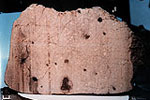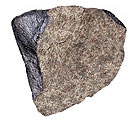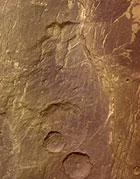Meteorites from the Moon and Mars
Although almost all meteorites that land on Earth come from the asteroid belt, some come from the Moon and Mars. We can study these samples to learn about parts of the Moon and Mars that have not been visited by astronauts or spacecraft.
In the video above, Museum meteorite expert Caroline Smith discusses the Tissint meteorite, a rare Martian meteorite that has been added to the Museum’s collections, and explains how we know it's from Mars.

How do we know that these rocks come from the Moon?
The meteorites that come from the Moon are the same age and have the same composition as rocks that were brought back by the Apollo astronauts and by the Russian Luna robotic probes. So they must have come from the Moon.
How do we know that these rocks come from Mars?

It is more difficult to prove that there are meteorites from Mars because no astronauts or spacecraft have yet brought material back to Earth. But Martian meteorites have clues to their origin buried inside. There are small pockets of glass in these rocks, and trapped inside the glass is gas that has the same composition as Mars' atmosphere.

The glass formed when the rocks were ejected from the surface by impact. The shock of the collision melted bits of the rock. The melt cooled very quickly, trapping inside it the surrounding atmosphere. We can melt the glass again, and analyse the gas. This is how we know the rocks come from Mars, because Mars' atmosphere is very different from any other planet.
What can we learn about Mars?

All the Martian meteorites are igneous rocks - they formed from melts. Some of them have been altered by water, and contain patches of carbonate minerals that were produced when water flowed across Mars' surface. By studying the carbonates, we can learn about the temperature of Mars' water, and how salty it was.
Is there life on Mars?

We now have many detailed pictures of the surface of Mars taken by orbiting spacecraft. They show that there seems to have been plenty of water on the surface of Mars in the past, and also that there were huge volcanoes. So Mars had energy and water, two of the necessities for life. That does not mean life is present on Mars - but it makes the red planet an interesting place to search.